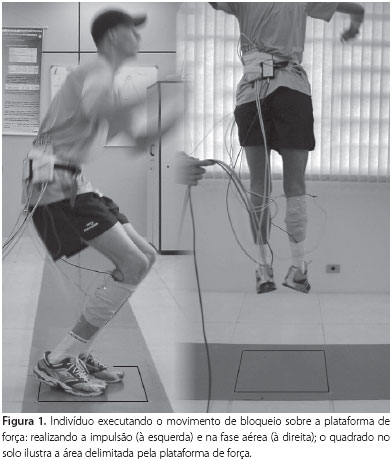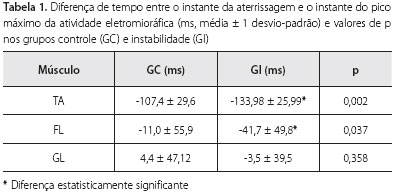INTRODUCTION: The ankle sprain is one of the most common injuries in athletes, including volleyball. 90% of ankle injuries in volleyball occur during landing after a blocking maneuver. The most common complication following ankle sprains is functional instability (FI), a condition that affect about 52% of the patients that suffered an ankle sprains . Functional ankle instability (FI) has been defined as a tendency for the foot to give way after an ankle sprain with no evidence of ligament injury. Hence, FI is an impairing condition for volleyball performance since it interferes in its basic skills. AIMS: The purpose of this study was to compare the EMG activation patterns of tibialis anterior (TA), peroneus longus (PL) and gastrocnemius lateralis (GL) in volleyball players with and without FI during landing after the blocking movement. METHODS: EMG activity was acquired for 21 subjects (mean age 20 ± 4 yrs) with FI (IG) and 19 control ones (CG). Linear envelopes were calculated for both groups for the time period between 200 ms before and 200 ms after the instant of impact, and time and magnitude of peak occurrence were extracted from the envelopes. Groups were compared using T test (α < 0.05). RESULTS: IG subjects showed a later peak occurrence for TA (CG = -107.4 ± 29.6 ms; IG = -134.0 ± 26.0 ms) and PL (CG = -11.0 ± 55.9 ms; IG = -41.7 ± 49.8 ms) and a lower peak magnitude for TA (CG = 68.5 ± 17.2%; FIG = 81.2 ± 28.8%) and PL (CG = 72.9 ± 27.3%; FIG = 59.1 ± 16.0%). CONCLUSIONS: These results suggest that individuals with FI present a later and lower activation pattern of muscular activity and different activation magnitudes that predispose them to ankle sprains, even in the absence of an anatomical damage.
joint instability; motor activity; electromyography; sports








